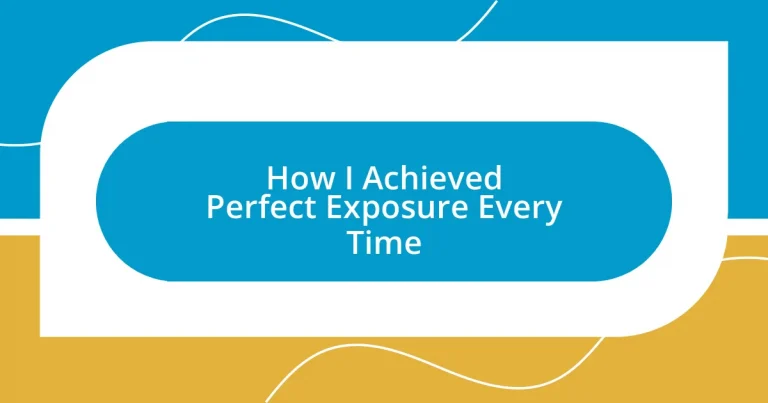Key takeaways:
- Understanding the interplay of aperture, shutter speed, and ISO is essential for achieving perfect exposure in photography.
- Utilizing exposure compensation can significantly enhance image quality by allowing photographers to adjust for challenging lighting conditions.
- Post-processing techniques, such as adjusting exposure, contrast, and curves, can transform photos and help highlight intricate details.
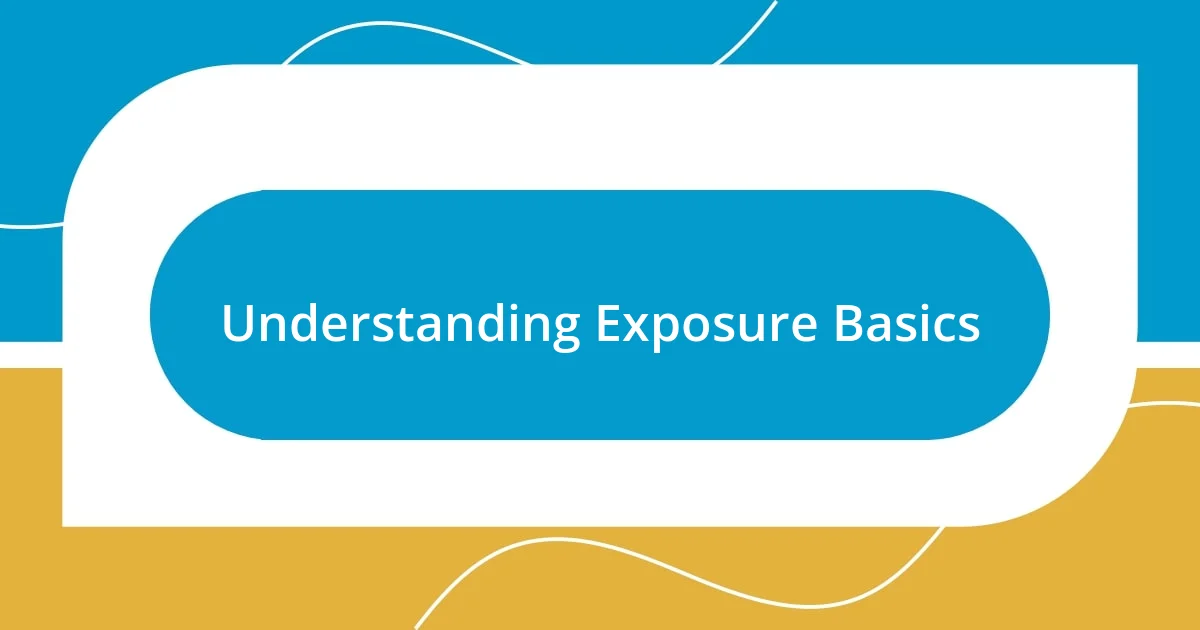
Understanding Exposure Basics
Understanding the basics of exposure is crucial for every photographer. Exposure is essentially the amount of light that reaches your camera’s sensor. Have you ever taken a photo only to find it either too dark or blindingly bright? I know that feeling all too well; it’s frustrating to capture a perfect moment only to have it ruined by poor lighting.
There are three main elements that control exposure: aperture, shutter speed, and ISO. Think of aperture as the eye of your camera – it can open wide to let in more light, or close down to keep it darker. I once experimented with a wide aperture while shooting a friend’s wedding; the beautiful blurred background captured the emotion of the moment perfectly. This adjustment helped me realize how powerful aperture can be in crafting depth and focus in an image.
Shutter speed, on the other hand, dictates how long your camera’s sensor is exposed to light. I remember shooting a fast-moving soccer game, and I quickly learned that too slow of a shutter speed makes everything look like a blurry mess. Likewise, adjusting the ISO lets you brighten or darken images without changing the other settings. Have you ever tried shooting indoors without enough light, only to produce grainy photos? Trust me, I’ve been there too; the balance of these three elements is what I strive to master—it’s a dance that, once understood, leads to consistently perfect exposure.

Key Elements of Perfect Exposure
When I think about achieving perfect exposure, the interplay between the three key elements—aperture, shutter speed, and ISO—comes to mind immediately. Each element acts like a crucial player in a team, working together to produce the ideal image. There have been times when I was obsessively adjusting one of these settings only to realize that harmony among them is what truly creates the perfect shot.
- Aperture: This not only affects light but also depth of field. I once captured a sunset with a low f-stop, allowing the foreground blooms to pop vividly while the background softened beautifully.
- Shutter Speed: It can freeze action or create a sense of motion. I recall a day at the carnival, where I opted for a faster shutter speed to immortalize a spinning ride; the exhilaration leaped off the image.
- ISO: This element is essential in low-light conditions. I vividly remember chasing twilight at a beach bonfire. By adjusting the ISO, I managed to capture the glow of the fire without losing the details in the sky, balancing the light perfectly.
Getting comfortable with these three elements is transformative. It’s a learning curve, but once you start to see how they interact, you’ll find that perfect exposure isn’t just a rare stroke of luck—it’s a skill you can cultivate.
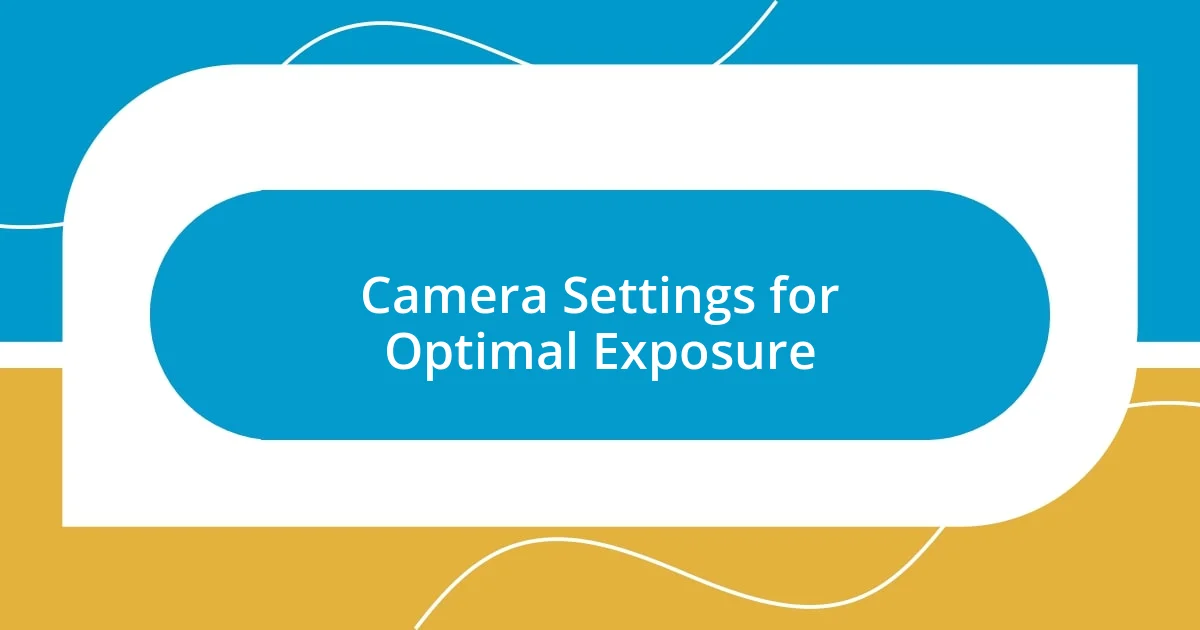
Camera Settings for Optimal Exposure
When it comes to camera settings for optimal exposure, I can’t emphasize enough how crucial it is to find the right balance between aperture, shutter speed, and ISO. Each setting influences the outcome, and understanding how they interconnect is vital. For instance, during a recent family hike, I opted for a larger aperture to beautifully blur the background while capturing my kids in sharp focus against the breathtaking landscape. It’s moments like these when I see how a small tweak can elevate my photos dramatically.
The shutter speed is equally important, especially if you’re shooting fast action, like my dog’s playful antics at the park. I remember trying to catch a shot of him mid-leap, and adjusting to a faster shutter speed saved that moment from becoming a blurry memory. I was genuinely thrilled to capture the joy and energy he exuded! Effective shutter speed choices can freeze time or allow for artistic motion blur, depending on your vision.
Finally, there’s ISO. It’s my go-to setting when I’m working in challenging light, like that beautiful evening event I attended last summer. I increased the ISO to make sure I didn’t lose the ambience of the candlelight while keeping details intact. I learned the hard way that too high an ISO can introduce noise, but finding the sweet spot transforms otherwise dull images into stunning captures. Mastering these settings can lead to breakthroughs in your photography journey, consistently resulting in those coveted perfect exposures.
| Setting | Description |
|---|---|
| Aperture | Controls light entry and depth of field; wider openings allow more light but less focus depth. |
| Shutter Speed | Dictates the duration the sensor is exposed to light; faster speeds freeze action while slower can create motion blur. |
| ISO | Affects sensor sensitivity to light; useful in low-light but can introduce graininess at higher levels. |
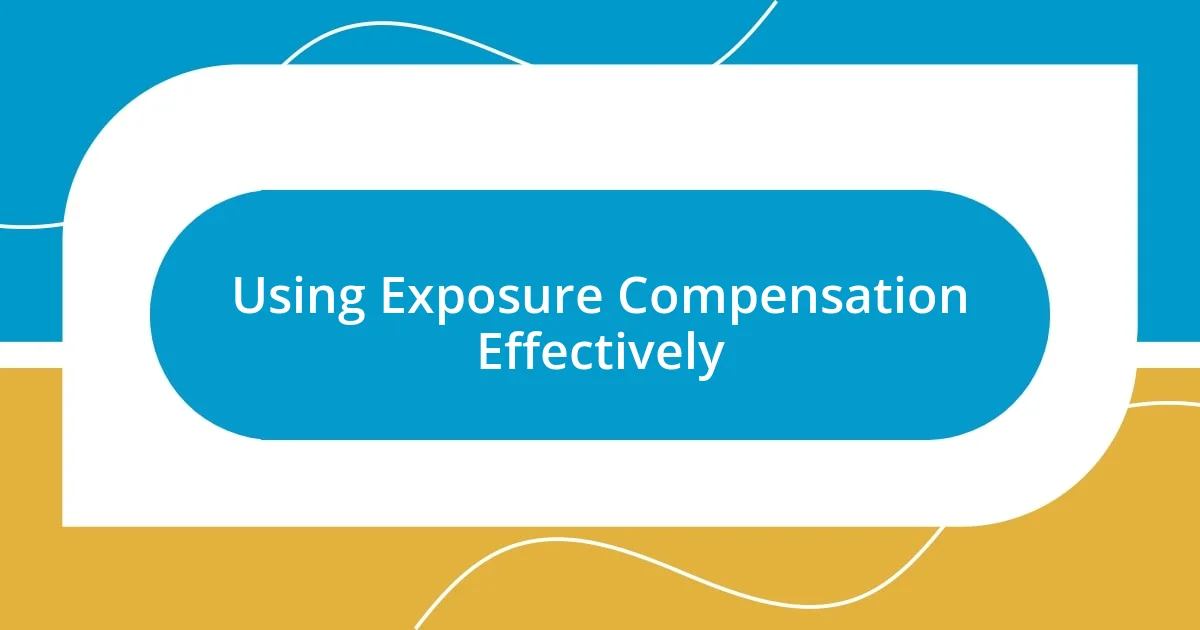
Using Exposure Compensation Effectively
Using exposure compensation can be a game changer in achieving the perfect shot. I remember standing in a bustling market, surrounded by bright colors and varying light conditions. The camera’s automatic settings struggled to keep up, leaving my vibrant shots looking muted and lifeless. By stepping in and dialing the exposure compensation up, I was able to enhance the vibrancy of those colors, bringing the scene to life. It’s fascinating how a minor adjustment can drastically change the outcome.
Have you ever found yourself shooting a winter landscape, the snow reflecting glaring sunlight? I certainly did during a recent trip to the mountains. My camera’s automatic settings were fooled by the brightness, leaving my snow-covered scenery looking gray and flat. I learned to use exposure compensation to deliberately underexpose the shot. This simple act of making an intentional choice showcased the beauty of the snow while keeping the details intact. It reminded me just how vital it is to understand and take control of our settings instead of letting the camera decide.
Another moment that stands out happened during a stunning sunset beach session. The sun dipped precariously, casting brilliant hues across the sky but also creating harsh backlighting. I instinctively adjusted the exposure compensation to compensate for the bright background. This morning, I realized the importance of those little adjustments to balance my subject against the intense light. This experience reinforced my belief that mastering exposure compensation transforms your ability to capture exquisite images every time. Why leave it to chance when you can take charge?
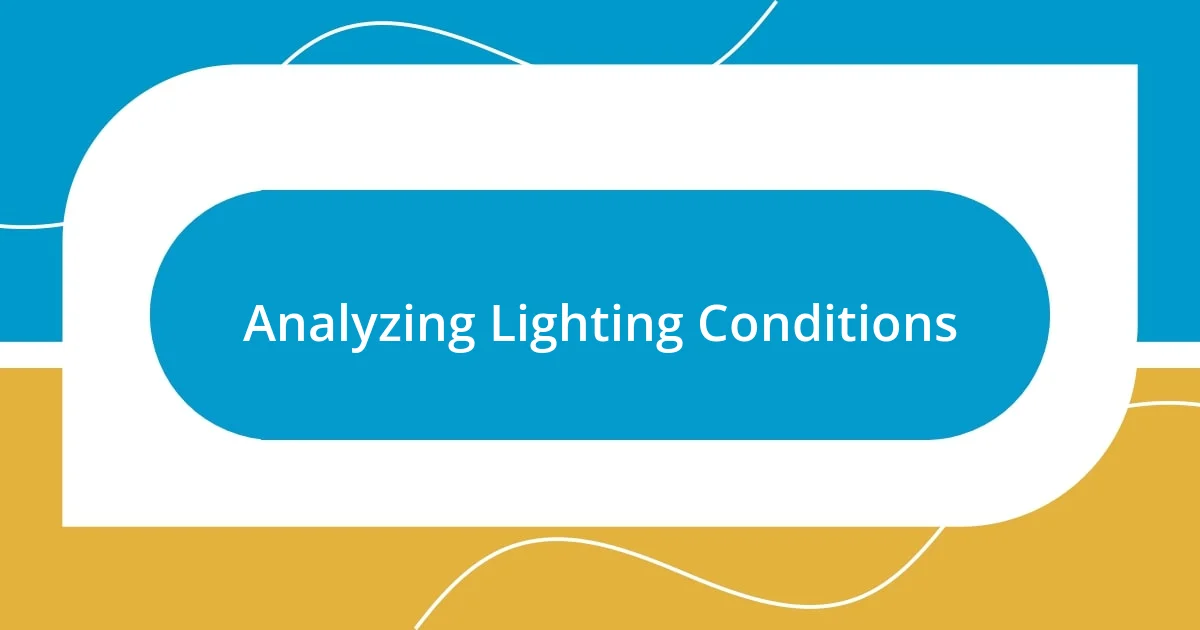
Analyzing Lighting Conditions
Analyzing lighting conditions is like looking at a puzzle where every piece impacts the final picture. I still vividly recall one early morning, while I was setting out to capture the mist rising over a tranquil lake. The soft light bathed everything in a gentle glow, revealing how crucial it is to identify the quality of light. Understanding if you’re dealing with soft or harsh lighting can drastically change the mood of your images and help you make better exposure decisions.
One of the lessons I learned is that the direction of light plays an integral role in your photography. During a golden hour shoot, I remember placing my subject with the sun behind them, creating a beautiful halo effect. However, I struggled for a moment with backlighting while trying to capture their features. It made me realize that, sometimes, the most beautiful light can also pose challenges. Knowing how to analyze and tackle these lighting conditions allows for more creative expression. Have you ever found yourself adapting your position to harness the light just right? It’s a game of patience and intuition.
Reflecting on my experience in a dimly lit café, I was determined to document the cozy atmosphere. The overhead bulbs created uneven shadows, and my camera’s limited dynamic range struggled. I found that positioning myself near a window transformed the scene completely, leveraging that natural light to bring forth the warmth of the setting. It’s in those moments of trial and error, battling different lighting scenarios, that I truly appreciate how essential it is to analyze lighting conditions. Each experience enhances my understanding, and I believe it helps others too.
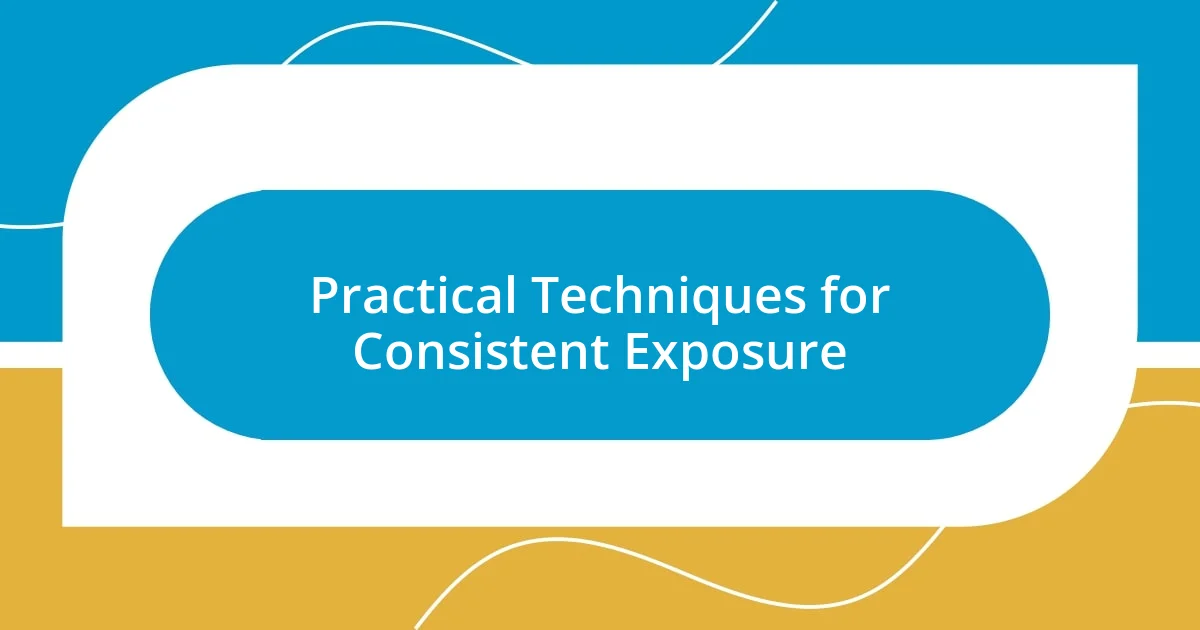
Practical Techniques for Consistent Exposure

Mastering Manual Mode
Mastering manual mode on your camera is a liberating experience! I still recall the first time I bravely switched from automatic settings to manual while capturing a breathtaking autumn scene. The vibrant reds and oranges of the leaves were mesmerizing, but I noticed that the light was playing tricks on my camera. Adjusting the aperture and shutter speed allowed me to control the depth of field and motion blur, resulting in a sharp image that perfectly captured the season’s essence. Doesn’t it feel amazing to take complete control?
When I first started exploring manual mode, it felt overwhelming. I remember attending a photography workshop where the instructor encouraged us to experiment with different settings. It was during a candid street photography session that I learned to adjust my exposure settings on the fly. The sun peeked through the clouds, creating beautiful, soft light, but as the clouds rolled back in, I quickly realized how vital my newfound skills were. It turned a potentially lost opportunity into a stunning collection of shots. Have you ever been caught off guard by changing light while shooting?
I believe that practice truly makes perfect. After weeks of experimentation, I became more confident calibrating my camera based on the lighting situation around me. Each click of the shutter was a step closer to finding the perfect exposure, and every failed shot felt like a lesson learned. It’s in this persistent pursuit that we discover our style and vision. Trust me, embracing manual mode is not just a technique—it’s about cultivating your artistic intuition.
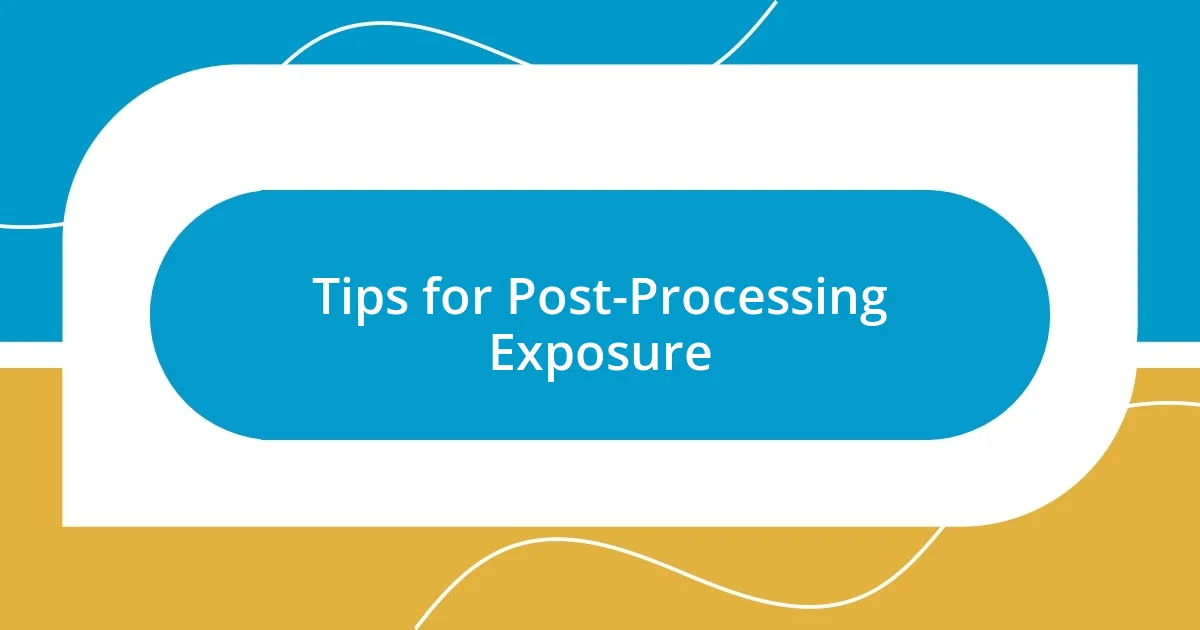
Tips for Post-Processing Exposure
Post-processing is an invaluable tool for perfecting exposure, allowing you to elevate your photos even if they weren’t flawless straight out of the camera. I still remember one evening editing a shot from a field trip; the lighting was poor, leaving my image with a dull, lifeless feel. By adjusting the exposure sliders in Lightroom, I discovered how a simple tweak could breathe new life into my photo, highlighting details I hadn’t noticed before. Have you ever been shocked by how a little adjustment can transform an image?
Playing with contrast during post-processing can also make a world of difference. I recall a particularly hazy shot where the foreground blended seamlessly with the background. By increasing the contrast, suddenly those soft features popped, giving the image a much-needed depth. It was like flipping a switch—what were soft details became crisply defined. I encourage you to explore this technique; you might be pleasantly surprised by the results!
Don’t overlook the power of using curves in your editing software. When I first started using curves, it felt intimidating; the interface looked like a math problem! But as I began experimenting, I realized how they let me control not just exposure but also tonal range. I vividly remember adjusting curves for a sunset photo. As I pulled up the highlights and slightly brought down the shadows, it felt like I was sculpting the light itself. That moment taught me that post-processing is not just about fixing mistakes; it’s an art form in its own right. Are you ready to dive deeper into your editing software and unlock its potential?












